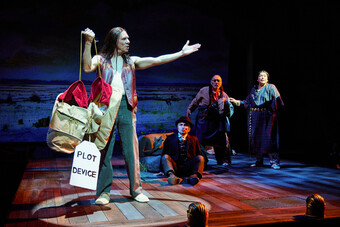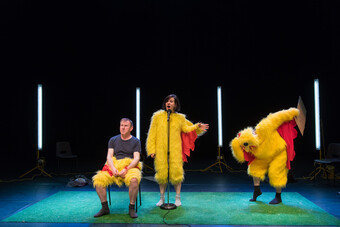Dialing the Suicide Hotline
It is this simple. Resistance will only make matters more difficult. Any resistance will only make matters worse. By law, I will have to restrain you. His tone suggests that you should try to understand the difficulty in which he finds himself. This is further disorienting. I am fine! Can’t you see that! You climb into the ambulance unassisted.
Sometimes when I talk to theater artists seeking their way and place in this field I like to read them this passage from Claudia Rankine’s Don’t Let Me Be Lonely. It’s right at the beginning of the book and she’s talking about how one minute we’re thinking about death and then we’re sitting in front of the television and then “call 1-800-SUICIDE” flashes across the screen and suddenly we find ourselves dialing the number. And then the ambulance arrives, and we climb into the ambulance “unassisted.”
I suggest this reflects the same kind of intentionality in becoming an artist. And in fact I argue the sequence of events is almost identical. You’re sitting around thinking about writing about death or directing death or dramaturging death because most stories are about grief and death anyway, and then the next thing you know, you feel like dying and then you think, “I’m fine.” But then you crawl into the ambulance of your own volition and are carted off into this world of theater, where resistance only makes matters worse—as I say repeatedly to my students or my interns or any emerging playwright. Just accept your suicidal impulses and figure out how to live with them and survive despite them.
Survival has been on our minds a lot these days. In fact, since Rocco Landesman gave his talk at the Arena Stage new play convening in January, we’re all asking ourselves whether or not we agree with him. Are there too many theaters for too few audience? Is supply out of whack with demand? This set off a panic across the country—“Does he mean me? My theater? Is he trying to off me?” And in this case what does it mean to get into the ambulance? Should we look inward and admit we’ve become a dinosaur in the field and move out of the way so some other artists can have a crack at it? Or does it mean that we should spend way less time defending our positions, trying to hoard our resources, and just get in the ambulance of art-making and get on with it?
I sent out a tweet saying I was bummed that the outcome of the convening had turned into a supply/demand conversation, as I wanted to talk about aesthetics. But trying to talk about aesthetics in 140 characters proved impossible for me. (I think poetry will return with a vengeance in the age of Twitter as I wished myself a poet in that moment, someone with the ability to convey a lot with a lot fewer words.) So I got depressed as I do when things don’t go my way and then I thought, how can I turn the supply/demand conversation in a direction that serves my selfish desire to talk about beauty and art?
We approach art like we approach a potential lover and in the initial stages that has everything to do with “what’s in it for me.”
I remember reading Walter Pater’s The Renaissance: Studies in Art and Poetry from 1873 in college. I loved Pater at that moment, in my coming of age as a thinker and a lover of art. Art for art’s sake has been a mantra I still like to pull out of my back pocket, a way of separating myself from the masses, my childhood in Elkhart, Indiana, and an encroaching sense that I might be expected to be held ever more accountable for my work in the age of accessibility and transparency.
Pater’s utterly self-reflexive questions: “What is this song or picture, this engaging personality presented in life or in a book, to me? What effect does it really produce on me? Does it give me pleasure? How is my nature modified by its presence, and under its influence?” This is the job of the aesthetic critic—to understand the impact of art in the most personal way. Me, me, me, me, me! In an ego-driven field—“what about my play? My directing? My institution?”—Pater has a lot to tell us about the aesthetic disposition and its incredibly selfish nature. Pater’s words echo some of the ideas conveyed in my earlier piece about the role of love in season planning, that we approach art like we approach a potential lover and in the initial stages that has everything to do with “what’s in it for me.” And if you look at the history of conversations on aesthetics, I’m hardly an expert, but one does see a progression in how we look at art, how we receive it, and how we make it.
The essay I’ve returned to for more than twenty years is Walter Benjamin’s “The Work of Art in the Age of Mechanical Reproduction.” In this essay, written in 1936, Benjamin considers both sides of the impact of reproduction (particularly in film, photography, and music) on how we assess the aesthetic impact of art. Benjamin has a great investment in what he terms the “aura” of a piece of art and the ability to reproduce art has a direct impact on our experience of aura—“that which withers in the age of mechanical reproduction is the aura of the work of art…by making many reproductions it substitutes a plurality of copies for a unique existence.” Accessing the original work of art becomes less of a priority and authenticity becomes more difficult to determine. Beauty becomes ever more subjective. The object and its author are supplanted by the experience of the audience.
Benjamin’s analysis of the democratizing impact of reproducibility presages our most pressing conversations in considering the future of theater as an art form. “It’s inherent in the technique of the film as well as that of sports that everybody who witnesses its accomplishments is somewhat of an expert. . . Similarly, the newsreel offers everyone the opportunity to rise from passerby to movie extra.” Benjamin predicts the impact of hyper reproduction on the arts, “the distinction between the author and the public is about to lose its basic character . . at any moment the reader is ready to turn to writer.” And isn’t this what we’re struggling with in the theater right now, what to do with this new generation of theater-goers (we call them millennials or the Web 2.0 generation) who want to participate and who want an experience that is in essence about “me, me, me, me, me"? This audience shouldn’t be so unfamiliar to us as they are driven by an impulse we’re very familiar with when we’re honest about it.
Interestingly in 1936, Benjamin references the theater as the art form where aura still prevails. Its “liveness” and lack of reproducibility allow direct access to the authentic qualities of beauty. So it’s no surprise that theater is the last art form to grapple with art in the age of mechanical reproduction—why so many pockets in the field are still holding firm to the idea that there is an infinite interest for any work, that if we make it, they will come. And as some parts of theater hold onto the past, history moves forward and theater morphs—whether it be National Theatre: Live in HD, or site specific work, or NewPlay TV, or multimedia installations and simultaneous Twitter feeds—the theater is undergoing a democratizing moment that we cannot avoid. And our challenge? Whether to embrace things like the pro-am movement, or Meiyin Wang’s call for the plumber/poet in her provocative piece in this journal, or using audience as actors (in an upcoming piece for HowlRound by Aaron Landsman). If we are to survive our own ego-mania, we must embrace it and get into the ambulance unassisted. Resistance will only make matters more difficult.










Comments
The article is just the start of the conversation—we want to know what you think about this subject, too! HowlRound is a space for knowledge-sharing, and we welcome spirited, thoughtful, and on-topic dialogue. Find our full comments policy here
Let's have an aesthetics day - somewhere in DC - I'll organize, we'll invite only the people we want to invite and we'll find a ruthless moderator who can steer the conversation back to topics at hand. I'm serious.
Lest we go too far in claiming this as a postmodern phenomenon, the medieval mystery plays were productions created not by artist-specialists within a set building selling commodities, but rather created by artist-plumbers (or artist shipbuilders, artist-bakers, and so forth) creating and performing community-based productions in the streets of towns like York. We have converted the arts into commodities created by artist-specialists and sold to passive consumers -- that's what's killing us.
Benjamin was amazingly prescient in his prediction that every audience member would become a writer, re-wiring the traditional author/ audience relationship. I will return to this exciting idea later, but first, let's look at how the not-for-profit theatre currently frames the audience/ author relationship.
The "frame" or "authorship" of the work of art in the age of regional theatre can be read through the physical stage, which in its architecture is a metonym of all the authorial relationships within which it's embedded. It's nestled within the building (product of a successful capital campaign running into the millions) which is nestled within a web of marketing, financial and programming relationships. And outside of this set of interlocking Russian dolls, the playwright and other freelance (labor for hire) artists wait anxiously.
If "authoring" means framing an experience through access to its means of production, then playwrights are less and less this "author." The frame in many ways IS the story (McLuhan), and in the not-for-profit theatre, that frame is bought and sold by funders, boards and artistic directors, and put up in physical space. To then put a play in that space frames it as product, content, for a pre-ordered set of aesthetic rules which the theatre, not the playwright, has defined in both physical and metaphorical space. That frame may be congenial or poisonous to the play, but in either case, the play doesn't have the wiggle room to define its own, and (as product) it isn't supposed to.
However, the power to shape the frame around the work is a key part of authorship, because it defines the terms of engagement with the work and crucially, shapes the rules of reception and intelligibility. For instance, a proscenium space is organized around the now old-fashioned notion of a masterful perspective--a gaze that can fit everything into the frame and make mimetic sense of it. Not surprisingly, plays that draw on "realistic" tropes tend to do well in this space.
However, post-modern or fragmented or neo-expressionist work is virtually incomprehensible from this viewpoint, into which audiences are physically (and symbolically) placed. How can we know that audiences are conservative, when the theatre puts them---literally---in a conservative position? In a red plush seat overlooking a chocolate box world. They might love other kinds of work if they had the chance to see it in a framework that made sense of it.
I think most playwrights are anxious to do all they can to connect with audiences; what we don't want to do is simply make product for a frame that doesn't suit the work. We see part of our work as structural: to construct a frame that invites the audience into the world of the play. If that frame is disregarded or worse, dismantled in favor of the default rule-box of a given theatre, bad things will happen. The play will fail because the audience will lack the proper invitation to enter it through its own rules.
However, happily the converse is true too. Once we grasp that the organization of physical space powerfully communicates the rules of the game, exciting possibilities abound for inviting audiences into new rules, new games. Thoughtful framing can make otherwise "difficult" work intelligible.
For instance in Punchdrunk's Macbeth, presented in Boston by the A.R.T., the audience puts on a white mask and is guided into an empty, eerie space. It doesn't take long to intuit that we are ghost-witnesses to a crime scene. Indeterminacy, chance, incomplete story--these are effects of audience position, and part of the thrill of wandering through the elaborately installed world. A Hitchcock soundtrack cues postmodern collage and crime scene thriller expectations. And as white masks, including your own, cluster around a murder scene, you realize that you are part of this story--a blood cell in the story's circulation.
The fragmented scenes of that work, played on a proscenium stage, would simply have read as incoherent, failed pastiche. But the audience completed the story because they were invited into the frame as authors of their own experience WITHIN the world of the performance.
This brings me back (OK, it's been a long detour) to Polly's comment about the audience/ writer. I don't think the audience desire for involvement is as facile, or even as of-the-moment, as just wanting to text through performances or be able to dance on stage. I think it's more that the frames of our conventional theatre struggle to generate a 21st century mimesis. The rules have changed--film is (or was til recently) the medium of mimetic realism, using a photographic similitude to position the dreaming "I" in the center of its shifting point of view. Film feels closer to "live-ness" in its construction of point of view through the subject's embedded camera eye. The fixed-perspective proscenium stage feels woefully old-fashioned for the kind of immersive, empathetic engagement that's theatre's core power.
I think writers know this and are writing for new frames, new points of view (and I don't mean "opinions"--I mean literally, positions to view from). But the chocolate-box theatres struggle to stage these plays because they don't fit the frame. Sooner or later, the frame will have to melt and refashion itself around the work, instead of trying to lure the flown bird back into an ornate but rusting cage.
I can't imagine wanting or needing to resist. Theater is what I was born to do; little else is as joyful as submitting to it.
Resistance is indeed futile...an example of another discipline, and where cracks are appearing in the traditional experience of artist/spectator relationship...
http://online.wsj.com/artic...
Have you seen Elizabeth Gilbert's TED.COM talk on nurturing creativity?
It is a huge perspective-giver...
http://www.ted.com/talks/el...
We must stop this suicidal tendency among our creative minds. Or maybe it's just population control...
Thick and thought-provoking - thank you Polly for kicking my brain into high gear.
To quote a show whose continued survival and rebirth--not to mention its spinoffs into other media--is directly attributable to its fans and their participation, "Resistance is futile."
In many ways, "Star Trek" is an example of how intense fan interest--audience engagement--can change an industry. Until the fans saved the original series from cancellation, there hadn't been a "save our show" campaign. It led to fan fiction, conventions, an animated series, eventually a proposed new series that evolved into films after "Star Wars" came along. This spawned four more television series, ten more films (and counting) and hundreds of novels, comic books, audio dramas, etc.
Of course, nowadays, such fan investment in television is a common thing.
If we really want to, we can engage our audiences. The question is, how do we go about that? What's the "Star Trek" to change our industry?
(Honestly, I just meant to make a "resistance is futile" joke and then I got to thinking. Thanks a lot, Polly Carl, making me think and stuff.)